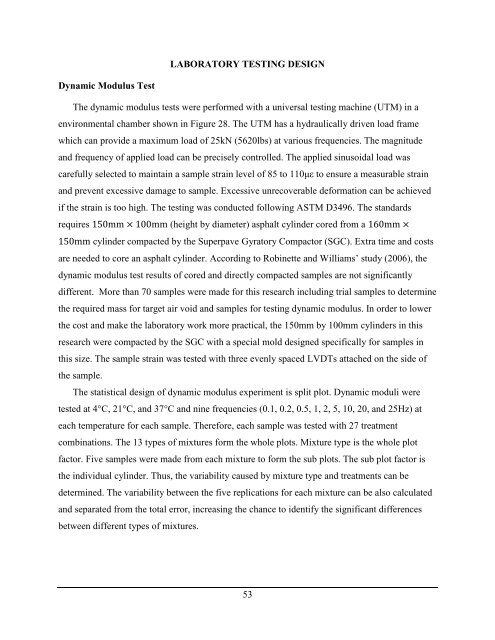Modification of Dynamic Modulus Predictive Models for Asphalt ...
Modification of Dynamic Modulus Predictive Models for Asphalt ...
Modification of Dynamic Modulus Predictive Models for Asphalt ...
You also want an ePaper? Increase the reach of your titles
YUMPU automatically turns print PDFs into web optimized ePapers that Google loves.
LABORATORY TESTING DESIGN<br />
<strong>Dynamic</strong> <strong>Modulus</strong> Test<br />
The dynamic modulus tests were per<strong>for</strong>med with a universal testing machine (UTM) in a<br />
environmental chamber shown in Figure 28. The UTM has a hydraulically driven load frame<br />
which can provide a maximum load <strong>of</strong> 25kN (5620lbs) at various frequencies. The magnitude<br />
and frequency <strong>of</strong> applied load can be precisely controlled. The applied sinusoidal load was<br />
carefully selected to maintain a sample strain level <strong>of</strong> 85 to 110με to ensure a measurable strain<br />
and prevent excessive damage to sample. Excessive unrecoverable de<strong>for</strong>mation can be achieved<br />
if the strain is too high. The testing was conducted following ASTM D3496. The standards<br />
requires<br />
(height by diameter) asphalt cylinder cored from a<br />
cylinder compacted by the Superpave Gyratory Compactor (SGC). Extra time and costs<br />
are needed to core an asphalt cylinder. According to Robinette and Williams’ study (2006), the<br />
dynamic modulus test results <strong>of</strong> cored and directly compacted samples are not significantly<br />
different. More than 70 samples were made <strong>for</strong> this research including trial samples to determine<br />
the required mass <strong>for</strong> target air void and samples <strong>for</strong> testing dynamic modulus. In order to lower<br />
the cost and make the laboratory work more practical, the 150mm by 100mm cylinders in this<br />
research were compacted by the SGC with a special mold designed specifically <strong>for</strong> samples in<br />
this size. The sample strain was tested with three evenly spaced LVDTs attached on the side <strong>of</strong><br />
the sample.<br />
The statistical design <strong>of</strong> dynamic modulus experiment is split plot. <strong>Dynamic</strong> moduli were<br />
tested at 4°C , 21°C , and 37°C and nine frequencies (0.1, 0.2, 0.5, 1, 2, 5, 10, 20, and 25Hz) at<br />
each temperature <strong>for</strong> each sample. There<strong>for</strong>e, each sample was tested with 27 treatment<br />
combinations. The 13 types <strong>of</strong> mixtures <strong>for</strong>m the whole plots. Mixture type is the whole plot<br />
factor. Five samples were made from each mixture to <strong>for</strong>m the sub plots. The sub plot factor is<br />
the individual cylinder. Thus, the variability caused by mixture type and treatments can be<br />
determined. The variability between the five replications <strong>for</strong> each mixture can be also calculated<br />
and separated from the total error, increasing the chance to identify the significant differences<br />
between different types <strong>of</strong> mixtures.<br />
53
















